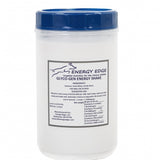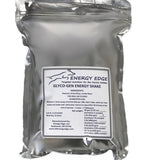Energy Edge ~ Recovery
Feed for energy with Energy Edge, so your dog will feel stronger and respond faster!
Facts:
- Replenish Energy After Exercise Year Round.
- Recharge Muscle Strength & Restores Focus.
- Helps to Fight Fatigue on Warm Days.
- Assists with Recovery after Illness or Vaccines.
- Safe for Dogs of All Ages.
- Great for Senior Dogs Needing a Boost Before/After Exercise or in the heat.
-
3 Simple Ingredients: Maltodextrin, Whey Protein & Vanilla.
- 100% Natural Food with No Fillers or Additives.
- 2 grams of protein per tablespoon.
-
USA Made.
Developed by a veterinarian, Angie Untisz DVM, for canine athletes and working dogs. With Energy Edge you will have a dog that is more responsive and less prone to physical injury.
No electrolytes, because dogs don’t sweat! Any excess electrolytes that a dog ingests need to be flushed from it’s system, or it can cause an imbalance. This can lead to cellular dehydration. Dogs can’t perform well when dehydrated.
Why Whey? A small amount of protein allows the carbohydrate to be utilized better. Whey protein is very unlikely to cause an allergic reaction in dogs with food allergies.
Select Drop Down Menu to Choose from: Shake Mix or Bones in Resealable Mylar Bag.
Glyco-Gen Shake Mix:
Maltodextrin, Whey Protein and vanilla flavor. No added supplements, electrolytes, or dyes. Just the energy building nutrition your dog needs when he needs it. One tablespoon per 10 pounds of dog body weight added to water. It just takes a little water to mix into a shake like consistency.
Pro Tip:
Most dogs like the taste of the Energy Edge. If you have a "picky" eater, we suggest mixing the powder with something that your dog really enjoys. After adding water to the mix, you can a bit of broth, food or treats to enhance the taste if needed. The bones can be dipped into something tasty like peanut butter.
For more information, please contact us at info@planetbluedog.com.
____________________________________________________________________________________________________________________________
Frequently Asked Questions:
Doesn’t sugar/starch do the same thing?
Sugars (glucose, fructose, corn syrup) are very hydrophilic. That means they need to be given with large amounts of water or they may draw water into the gut from the body. In some dogs this causes gastric upset (vomiting/diarrhea) and even dehydration! Starches (bread, potatoes, rice, barley) require digestion to break them down into sugars that can be absorbed. This process takes time and, unfortunately, the window of opportunity to utilize the GLUT4 pathway closes long before the starch can be fully digested.
What’s so bad about insulin?
Insulin is necessary to transport sugars into cells. As long as enough sugar is present, the body is balanced. Unfortunately, the sugar level in the blood drops before the insulin level, resulting in hypoglycemia (low blood sugar). Hypoglycemia causes fatigue and a sluggish response to commands. This effect is especially evident when large doses of sugar (or starches) are given.
Why doesn’t maltodextrin release insulin?
Maltodextrin is not a sugar. It is a small complex carbohydrate that doesn’t trigger the release of insulin.
When do I give Glyco-Gen Energy Shakes?
Glyco-Gen Energy Shakes should be given within 30 minutes of exercise. A second dose 45-60 minutes later may provide additional benefit to a very exhausted dog. In addition, if a dog tends to get exhausted during work, a half-dose given 15-20 minutes before work could prove helpful.
Customer Testimonial:
We ran in another tournament this weekend and used Energy Edge again. We are very happy with it! It helped our dogs perform well (the temperature was in the mid 80’s with 85% humidity).
Karl, Run Free Canine Center
____________________________________________________________________________________________________________________________
FEEDING FOR ENERGY IN WORKING DOGS, by Angie Untisz DVM
Working dogs are truly premier canine athletes. As such, one should pay close attention to meeting their energy needs. There are 3 sources of energy… fats, carbohydrates and proteins. Understanding how the working dog utilizes energy and how best to balance these energy stores can result in a more responsive partner that is less prone to physical injury. Fats are the most energy dense of all the sources providing 70-90% of the energy needed for muscle contraction (primarily fueling slow twitch fibers). In the working dog, 50-65% of total energy in a diet should come from fats. (This translates to 20-25% fat on a dry matter basis.) When fed a high fat diet, the working dog will develop pathways that promote aerobic oxidation of free fatty acids (fat adaptation). In addition, adding an anti-oxidant such as Vitamin E and the amino acid l-carnitine can improve the muscle’s use of fat. Aerobic oxidation of free fatty acids leads to less lactic acid build up in the muscle and better endurance. Carbohydrates are stored in muscle as glycogen. Muscle uses glycogen during the initial moments of activity and for bursts of speed and power (primarily fueling fast twitch fibers). Glycogen stores are relatively small and can be rapidly depleted leading to muscle weakness and fatigue. However, diets high in carbohydrates can lead to de-conditioning (poor endurance, obesity, muscle injury). For a working dog, carbohydrates should be limited to 10-15% of the total energy in the diet. To improve the working dog’s use of carbohydrates, one should focus on replenishing glycogen stores and slowing glycogen depletion. Replenishing glycogen stores is accomplished by providing a “good carbohydrate” at an appropriate time. Muscle cells have GLUT4 pathways that are active during exercise and for up to 30 minutes after exercise. These pathways allow for the uptake of carbohydrate into the muscle without the release of insulin. Simple sugars (glucose, dextrose, fructose, corn syrup) cause an insulin release that leads to subsequent hypoglycemia (low blood sugar). Complex starches (bread, rice, grains) take too long to be digested and absorbed. Both cause fluid imbalances that can contribute to diarrhea and dehydration. Maltodextrin is a small complex carbohydrate and is the ideal carbohydrate for this purpose. Maltodextrin is rapidly absorbed without an insulin release or fluid imbalance and is readily utilized by the GLUT4 pathway. When a maltodextrin supplement is given within 30 minutes of exercise, up to 85% of pre-exercise glycogen levels are restored. Without this targeted approach, only 40% of ore-exercise levels are restored. Slowing depletion of glycogen stores is accomplished in two ways. First, when enough fat is fed, slow twitch fibers will use free fatty acids as their energy source (fat adaptation) sparing glycogen for use by fast twitch fibers. Second, supplementing prior to activity with a “good carbohydrate” such as maltodextrin will give the working dog a little carbohydrate “to burn” before starting on the glycogen stores. It is very important to avoid simple sugars and starches to avoid insulin spikes and fluid imbalances. Proteins are the building blocks of muscle and should not be a major source of energy. Animal source proteins (chicken, beef, lamb, egg, etc.) are preferred and often offer increased digestibility with a good amino acid balance. Diets low in protein have been associated with increased injuries. A working dog diet should have a minimum 26% protein. For hard working dogs, diets containing 30-40% protein are even better. The goal is to spare the use of protein as an energy source so it can be used to build muscle mass and repair muscle damage. In summary, working dogs should be fed a diet high in fat to optimize energy availability and high in protein to protect against injury. Carbohydrates should be supplemented at appropriate times to improve their storage. Feed appropriate amounts to provide energy but avoid obesity! Always have plenty of fresh water available.
PRACTICAL USES FOR ENERGY EDGE:
Agility Dogs: Since agility runs are often of fairly short duration, agility dogs use primarily carbohydrates for all their energy needs. Use Glyco-Gen Energy Shakes or Bones after each run to replace carbohydrates quickly and efficiently. The result is a dog at the end of the day with the same energy level with which she/he started!
Dock Dogs: Sprinting and jumping are “fast –twitch” activities requiring carbohydrates to supply quick, intense energy. Using Glyco-Gen Energy Shakes or Bones after each run will keep carbohydrate stores full and ready for a longer jump!
Herding Dogs: On the ranch or on the trial field, herding dogs use carbohydrates constantly. Fatigue results in a less responsive dog especially noticed during stressful chores such as shedding and penning. Maintain physical and mental energy by giving Glyco-Gen Energy Shakes or Bones every 45-90 minutes or after each trial run. Use 30-45 minutes before work when energy demands are high.
Hunting Dogs: Working hard in the field all day depletes a dog’s carbohydrate stores. Using Glyco-Gen Energy Shakes or Bones every 45-90 minutes will maintain a dog’s energy level without draining her/his carbohydrate stores resulting in more energy throughout the hunt.
Police Dogs: A police dog must be ready to work at any moment. Giving Glyco-Gen Energy Shakes or Bones after each search will quickly restore carbohydrates readying the police dog for the next call.
SAR Dogs: Hard work in tough terrain stresses the Search and Rescue dogs during training and actual searches. Using Glyco-Gen Energy Shakes or Bones every 45-90 minutes will stabilize energy resources and ward off both physical and mental fatigue.
Show Dogs: When dogs are excited or stressed, the adrenal glands release cortisone and adrenaline. These hormones cause the release and consumption of glucose resulting in the depletion of glycogen (stored glucose). In addition, glucose is the primary nutrient for brain functions. Keeping glycogen stores full allows for a steady level of glucose to the brain, which means a brighter, more responsive dog! For best results, administer Glyco-Gen Energy Shakes or Bones after showing in the ring to replenish glycogen stores.
Training Dogs: During training, keeping a dog bright and receptive to new behaviors can be challenging. As glycogen stores are depleted and glucose levels drop, the brain is less able to retain new information. Use Glyco-Gen Energy Shakes or Bones to provide targeted nutrition during and after training to keep the brain fresh and ready to learn.




